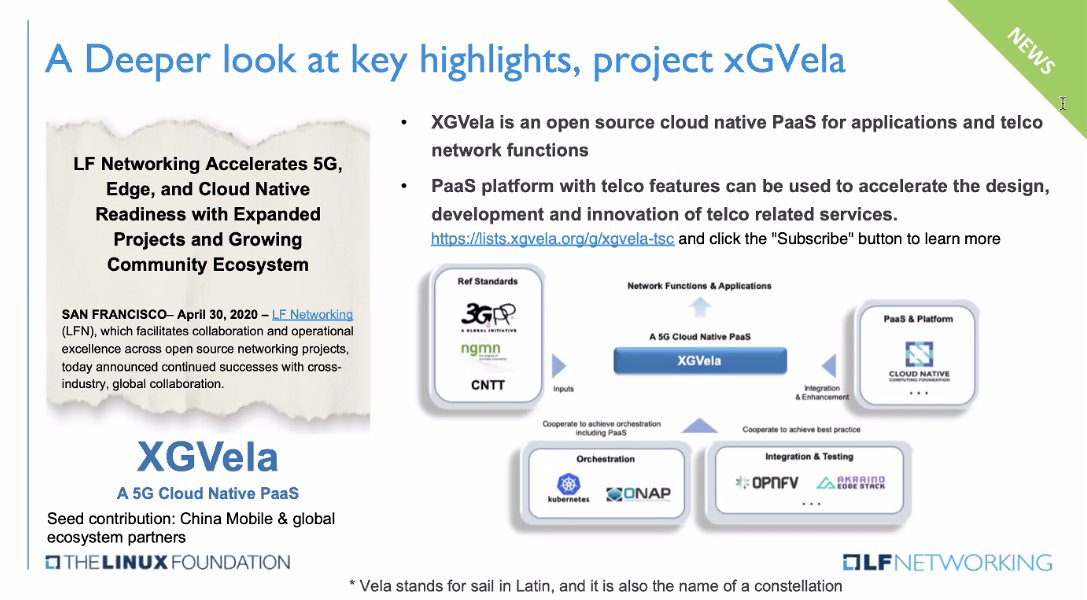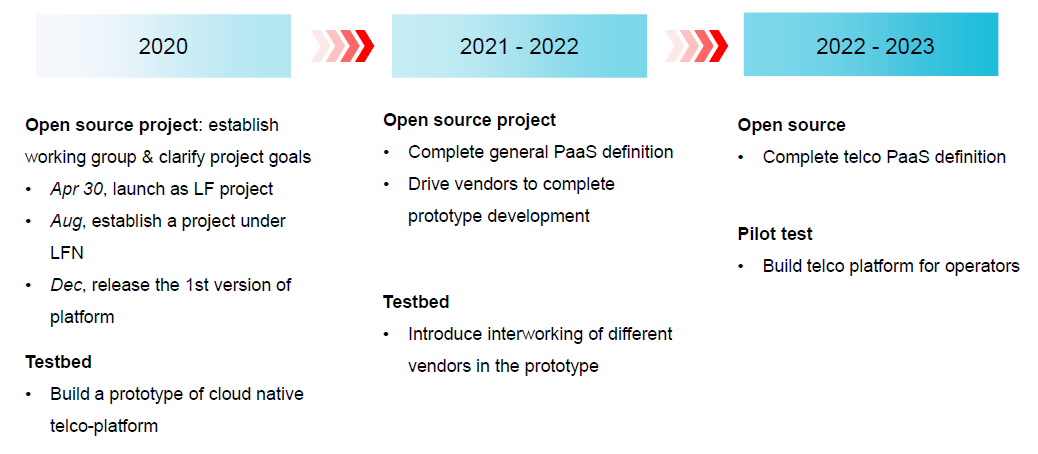This page is in Draft and not ready for TAC consumption.
Instructions
This document is a template to collect the data LFN thinks are relevant to LFN Project health. Projects will copy this template and instantiate it with their data as a part applying for lifecycle state transitions.
Click the "..." in the upper right hand corner of this page. Click "Copy". Choose "Project Proposals". Rename the title to your Project
If the project has instantiated this template before they are welcome to start from that base and update it with any new information. Be sure that the data requested by the primary copy of the Project Data Template has not changed.
These instructions should be removed from the instantiated template.
Project Data
Donated by LFN member China Mobile, XGVela provides a PaaS platform to accelerate the design, development and innovation of telco-related services, and is the first open source platform-as-a-service (PaaS) for 5G network functions
The project refines common capabilities of upper layer services as PaaS functions on platform layer. The platform brings General PaaS functions from existing open source PaaS component projects (e.g. Grafana, Envoy, Zookeeper, etc.) to be enhanced with telco requirements, and Telco PaaS which has strong telecommunication characteristics and is under exploration.
Partners include China Mobile, China Unicom, China Telecom, ZTE, Ericsson, Nokia, H3C, CICT and Beijing University of Post and Telecommunications.
Project Vitals
Basic information about the candidate project.
- Project name: xGVela
- Project creation date
- Project license
- Project release schedule
- History of at least two years or age of project
- Planned future release schedule
Statement of alignment with LFN Charter/Mission
The mission of the Project is to create an open source cloud native PaaS for applications and Telco network functions, which is to enable new services and help mobile operators to seize the business opportunity from vertical industries in the 5G era. The project can provide a reference design of Telco-PaaS and accelerate cloud native transformation for telecommunication industry.
The scope of the Project includes collaborative development under the Project License (as defined herein) supporting the mission, including documentation, testing, integration and the creation of other artifacts that aid the development, deployment, operation or adoption of the open source project.
Community Historical Trends
History of the candidate project's community.
The platform brings general PaaS functions from existing open source PaaS component projects:
- Grafana
- Envoy
- Zookeeper
GitHub Activity :
- April 2020- xgvela-xuxia: 9 commits in 1 repository
- Jan 2020- xgvela-xuxia: 4 commits in 1 repository
For each release or year for at least the last two years or the lifespan of the project, provide the following.
- Contribution statistics
- Number of commits
- Number of non-trivial (generated code, version bump, ...) commits >5k LoC
- Merged by uploader
- Merged by committer from same organization as uploader
- Merged without substantial code review
- If the candidate project has sub-projects, group these by sub-project
- Number of commits per-organization
- Contributor statistics
- Number of contributors
- Number of contributors per-organization
Community Current Status
Snapshot of the candidate project's community.
- Committer statistics
- Number of committers
- Number of committers per-organization
- Number of active committers
- Number of active committers per-organization
- Contributor approval process
- Contributor eligibility
- Process to become a contributor
- Process to remove a contributor
- Committer approval process
- Committer eligibility
- Process to become a committer
- Process to remove a committer
- Project governance structure
- Summery of project governance structure
- Summery of how project governance was established and can be modified
- Links to all public project governance documentation
- List of all community roles and details of how they are filled/emptied
- List of community roles that are elected
- List of community roles that are appointed
- List of people in all community roles and their organization affiliation
- User community
- Summary of project user community
Community Scope
Documentation
- Reference doc for cloud native network function and service design
- XGVela requirements doc, architecture doc, etc.
- XGVela platform User Manual
Development
- Telco PaaS (Functionalities, APIs, etc.)
Integration
- General-PaaS & Telco-PaaS
Testing
- XGVela with K8S (open source version, different vendor version)
- XGVela with cloud native NF
Certification
- Commercial product certification
Summary of Project functionality
- XGVela is an open source cloud native PaaS for applications and telco network functions, which is to enable new services and help mobile operators to seize the business opportunity from vertical industries in the 5G era
- Vela stands for sail in Latin, and also it is the name of a constellation. With XGVela, a PaaS platform with telco features can be used to accelerate the design, development and innovation of telco related service design.
Summary of Relationship with other communities, technology components, and purposes
- CNTT - Kubernetes and Container platform requirement
- Cloud Native Computing Foundation (CNCF)- inputs for XGVela code and integration based on telco requirements, to form General-PaaS
- ONAP- to achieve dispatch of PaaS abilities and orchestration of cloud native network functions
- OPNFV- to output a reference platform to support running and developing cloud native network functions
- Akraino- to output telco cloud native best practices
- Studies 5G NF microservice design method, develop and integrate Telco-PaaS.
Project Roadmap
Project Tooling
Details about the tooling used by the candidate project.
Note that the TAC has made a recommendation on infrastructure tooling. Please note where appropriate if you comply with these recommendations.https://wiki.lfnetworking.org/display/LN/Infrastructure+Working+Group+Summary+Report
- Bug tracker
- Links to bug trackers used by the candidate project.
- Integrated with any other relevant projects?
- To what extent are external/private bug trackers used?
- Chat tooling
- Links to chat tooling used by the project.
- Overview of chat tooling used by the candidate project.
- To what extent is external/private chat tooling used?
- Code repositories
- Links to code repositories used by the candidate project.
- Overview of code repositories used by the candidate project.
- To what extent are external/private code repositories used?
- Code review
- Links to code review systems used by the candidate project.
- Overview of code review norms, practices, conventions, rules.
- To what extent are external/private code review systems used?
- Continuous Integration tooling
- Links to CI jobs.
- Links to CI job definitions, infrastructure configuration.
- Overview of CI related to the candidate project.
- To what extent are external/private CI systems used?
- Documentation
- Links to documentation for the candidate project.
- Mailing lists
- Links to mailing lists used by the project and their archives.
- Overview of mailing lists used by the candidate project.
- To what extent are external/private mailing lists used?
- Meeting calendars
- Link to docs about meetings related to the candidate project.
- Overview of meetings held by the candidate project.
- To what extent are meetings public, and clearly publicly documented?
- Meeting minutes
- Link to archives for meeting minutes taken by the candidate project.
- To what extent are public minutes for meetings taken and shared?
Integrations
Details about technical integrations implemented by the candidate project.
- Summarize any existing or planned integrations with other projects.
- Summarize any CI/CD integrations with other projects.
- Summarize any other work that may enable integrations in the future.
- Continuous Delivery pipelines
- Configuration management tooling
- Documentation about cross-project integration
- APIs for cross-project integration
Vocabulary Reference
Explanations of domain-specific vocabulary.
.. todo:: Look into using special rst to make these definitions into tooltips
.. todo:: Consider extracting this to a stand-along file so can reuse elsewhere
- Active
- In this context, typically related to the activity level of a project or person.
- As a person: "Foo Committer on Bar Project has not sent any patches or done any code review for Bar in the last 12 months. Bar's Project Lead reached out to Foo Committer to discuss transitioning to an Emeritus Committer."
- As a project: "Bar Project has not had any non-trivial code changes merged in the last 12 months. The LFN TAC reached out to Bar Project to discuss transitioning to the LFN Archived lifecycle state."
- The LFN norm for "active" is about 12 months.
- Committer
- Person with permission to cause commits to be merged into a project's source control repositories.
- Contributor
- Person who has contributed to a project. "Contributions" are broadly defined. Examples include things like code, documentation, and bug tracker changes.
- Diverse
- In this context, typically related to the number of different organizations involved in a project.
- Downstream
- In this context, typically means the products based on a project. Community collaborates on upstream project, which is downstreamed by a company into a product.
- Alternatively, could relate to a relationship between two "upstream" open source projects (not by-company products) where one consumes (is downstream of) the other.
- As a verb: "to copy something from the open source project to a product based on it".
- As a dependency relationship: "Linux is a downstream of C".
- Upstream
- In this context, typically means the main open source project a community collaborates on. The code, tooling and people that comprise a project.
- As a verb: "to add something to the main open source project".
- As a dependency relationship: "C is an upstream of Linux".

